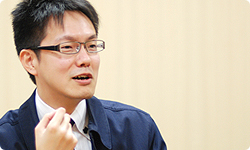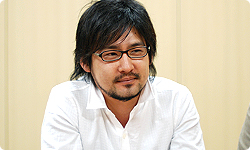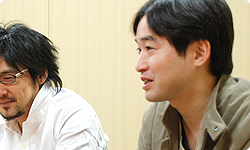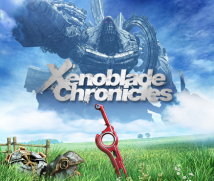4. The Drive to Get the Job Done
Kojima-san and Yokota-san, I’d like to ask you both to tell me about the special features of this title on the system side.
Well, the first is the seamless battle system we have implemented. RPG battle systems tend to be turn-based9 as it is more forgiving and the rules are simple to grasp. 9Turn-based battle systems mean that you alternate attacks with the enemy.
I think that may be the case for Japanese players especially.
Right. But with Xenoblade Chronicles, the map scrolls seamlessly, meaning you can go anywhere you like. If in spite of this, we used a turn-based battle system where the scene switches when you go into a battle, I think it would impede the player’s full immersion in the gameworld.
In this title, we’ve laid a great deal of importance on that sense of immersion in the world of the Bionis and Mechonis. That’s why we went with the seamless battle system.
So as the name suggests, with a seamless battle system, you go smoothly into battles without any sudden switch from the main game field.
Right. By making the battle system seamless, it means that you can enjoy more natural battle scenes, fought in real time. Moreover, we wanted to add a new element and implemented a foresight function known as Vision Mode to the battle system.
Can you explain this Vision Mode to me?
To put it very simply, it is the capacity to foresee future dangers that will befall either yourself or your companions. For instance, if you saw that your companion was about to find themselves in peril, you’d be determined to help them avoid that fate. This capacity is not just used to see the future in cut scenes , but you’ll also see sudden flashes of the future in battle, letting you alter your strategy , and thereby change the future by saving your companions .
So basically, in the heat of battle, you’ll see an image of what may occur just an instant or two in the future, and you can use that to your advantage in controlling your party.
That’s right. It means you can avoid danger, whether it’s by increasing an ally’s defence, getting a foe to turn the other way, or using a companion with a lot of stamina as a shield. This gives you the excitement of battle, along with that sense of relief when you sidestep danger, turning it into something that I don’t think anyone will have experienced before.

Takahashi-san, how responsive do you find this type of battle system?
I find it very responsive indeed. I think we’ve come up with a battle system where, in a constantly changing situation, you can utilise your companions’ powers to overcome problems you can’t deal with by yourself. Also, as your companions are calling out to each other, I think it has the feel of being on an adventure together with real, live players.
For instance, if you’re knocked flat by an enemy strike, your allies will sometimes give you a hand to get you back on your feet . When that happens, you’ll thank them, which serves to strengthen the bond between you.
Are these bonds between your party reflected in the game itself?
You have Affinity, which as the term suggests, represents the strength of the bonds between you and your party members. When you help out your companions, Affinity will increase, giving you an advantage in battle.
Affinity is not felt solely between your party members, but can also be built up with the people you meet in the towns. For example, if you successfully complete a quest that someone has asked you to do, this can deepen the Affinity between you and that townsperson. That person’s true worth may then be revealed.
That’s why I’d like players to not focus simply on progressing steadily through the story, but also to keep returning to towns between quests and speak to the townspeople again. If you do this, your Affinity will grow stronger and stronger.
By building up this Affinity with the townsfolk, we want the player to feel that it’s not just they who are living in the world of Xenoblade Chronicles, but that all sorts of people are going about their lives in the same world. I think that with RPGs, the player’s level of motivation is always very important. I wanted players to feel that they were fighting to protect this world inhabited by so many distinct characters.
It must have been really tough for Kojima-san, who was directing the development process, to populate such a vast world with so many people, and then to make them more and more detailed.
It certainly was. But we all had the single-minded drive to get the job done. After all, our escape routes were all blocked off! (laughs) That dedication to getting the job done was particularly pronounced in Takahashi-san, and when we saw how much he was giving, this helped spur us on. To take one example, all through the development process, Takahashi-san was constantly trying out the game. Now, it’s perfectly normal to try the game during the development stage, but every time I looked, I would think: ‘He’s still playing it...’ It’s the first time I’ve ever witnessed something like that.

That’s really a situation where you want to tell someone to stop him!
Right! (laughs) With this title, there were critical bugs that Mario Club10 hadn’t found which were spotted by Takahashi-san. 10Mario Club Co., Ltd. performs debugging, testing and so on for Nintendo’s software under development.
Wow. That’s really something.
He’d ask me if something was intended, and then when I replicated it, I’d see that sure enough, it was a bug, not a feature.
And those were bugs that you wouldn’t find unless you really knew the game inside out.
Exactly. Takahashi-san’s style used to be to work in his own office space and communicate his ideas via email, or speak to the team leaders, without coming into the development section.
I made it my practice to speak directly to the dev team as little as possible as my comments had seemed to be taken too seriously by them.
But with this project, things were different. He would come right into the dev team’s workspace and give direct instructions to the members of the team. This was something I’d hardly ever witnessed before, so we’d say: ‘Look, Takahashi-san has descended from the clouds...’
(laughs)
That was how intense his desire was to get the job done, and we were spurred on by that to really give it everything we had.
Why were you so driven and determined to get the job done with this title?
When I was younger, my sole aim was to express myself. If I enjoyed it, and could give the players a product that reflected my own taste, it was enough if it appealed to those players who understood what I was doing. I was compelled by the belief that this was where the appeal lay in an RPG.
So you had that sharp focus of youth, without any room to think of things from the perspective of the players.
Right! (laughs) But in a way, I think that was a really good thing. When you’re young, you’re brimming with creative energy after all, and it is a path everyone goes through. Among young game creators today, there is no shortage of people with the same approach I had, making games solely for those players who will understand what you are trying to achieve. I think that this sort of game is necessary in the video game industry. But now, when I ask myself if I still have that drive, which was in a sense rash and reckless, the answer is of course that I don’t. At the same time, I now have a better view of the overall shape of things, and I feel that my creative range has increased. Recently, especially since becoming a father of two, I’ve been thinking more and more about how to make a game that will be enjoyed by a large number of players and that will strike a chord with them.

So that explains why you were so determined to get the job done with this title?
Yes, that’s right.
